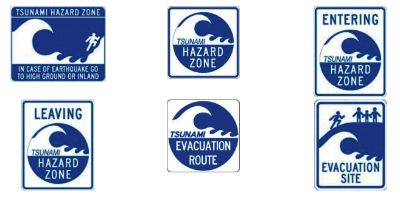
What is a Tsunami?
A tsunami is a series of powerful, fast-moving waves. Most tsunamis are generated by a large, off-shore earthquake, but they can also be caused by landslides, volcanic eruptions and even meteorite crashes. Waves can get up to 100 feet tall and travel 20-30 mph, and cause severe flooding and infrastructure damage when they reach land.
If the source is distant, you may have hours before waves arrive; if nearby, just a matter of minutes to get to safety.
While the LMU bluff is elevated enough to not be in the inundation zone, much of the surrounding area (including Playa del Rey, Marina del Rey, and the Ballona Wetlands) are within reach of a tsunami. Living by the coast, it's important to know how to respond in the unlikely event of a tsunami warning.
Prepare BEFORE
- Use the interactive tsunami inundation zone map to verify if you live, work, or otherwise frequent a vulnerable area.
- Know your evacuation route from anywhere you frequent that's in the inundation zone.
- Prepare emergency kits for your home, car, and workplace. Make a family communication plan.
- Learn the natural warning signs of a tsunami:
- FEEL the ground shaking
- SEE an unusual disappearance of water, or oncoming wall of water
- HEAR a loud roar coming from the ocean
- Be aware and informed.
- Confirm that your mobile phone is set up to receive wireless emergency alerts (WEAs) in your area.
- Purchase a hand crank (or battery operated) flashlight and radio, or purchase a NOAA weather radio receiver with an alert feature and Specific Area Message Encoding (SAME), to keep you informed of tsunami watches and warnings.
Survive DURING
- Be alert to natural warning signs: water may either drain or rise suddenly, or create a loud roar coming from the ocean.
- If you observe any natural warning signs, immediately move to high ground, as far inland as possible. Do not wait for official evacuation orders.
- If you are unable to quickly move inland, find a reinforced concrete building and get to the third floor or above.
- RUN if you see a tsunami coming.
- Stay away from rivers and streams that lead to the ocean; strong tsunami waves and currents may push water up these channels.
Stay Safe AFTER
- Follow all orders from local emergency officials. Tune in to local radio and TV stations for more info/updates.
- Stay away from coastal areas until officials permit you to return. Stay out of floodwaters, which can contain dangerous debris.
- If the tsunami was generated by a local earthquake, be alert for aftershocks.
Where Should I Go?
California coastal counties have tsunami hazard zone signs (shown below), that identify which areas may be at risk. Use the signs to guide you out of a tsunami hazard zone and to a safe area.

Additional Resources
- Interactive Tsunami Inundation Maps
- Sue Nami (USGS tsunami preparedness video)
- American Red Cross Tsunami Preparedness
- NOAA U.S. Tsunami Warning System